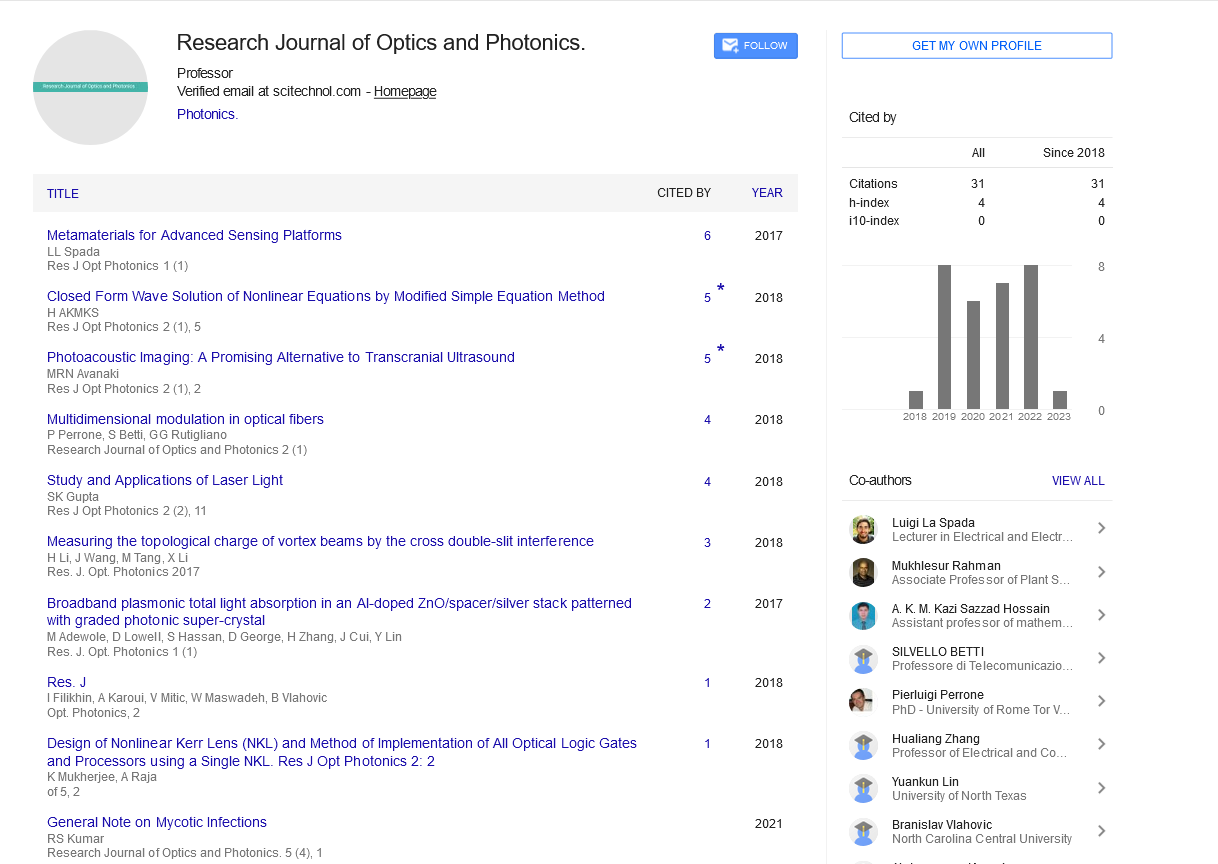Perspective, Vol: 8 Issue: 1
Ultrafast Optics: Unlocking High-Speed Phenomena with Femtosecond Laser Pulses
Karl Kratkiewicz*
Department of Bioengineering, Wayne State University, Detroit, Michigan, USA
- *Corresponding Author:
- Karl Kratkiewicz
Department of Bioengineering,
Wayne State University,
Detroit,
Michigan,
USA;
E-mail: kratkikarlwicz@wayne.edu
Received date: 21 July, 2023, Manuscript No. RJOP-23-107629;
Editor assigned date: 24 July, 2023, PreQC No. RJOP-23-107629 (PQ);
Reviewed date: 07 August, 2023, QC No. RJOP-23-107629;
Revised date: 15 January, 2024, Manuscript No. RJOP-23-107629 (R);
Published date: 22 January, 2024, DOI: 10.4172/RJOP.1000061
Citation: Kratkiewicz K (2024) Ultrafast Optics: Unlocking High-Speed Phenomena with Femtosecond Laser Pulses. Res J Opt Photonics 8:1.
Abstract
Introduction
Ultrafast optics, enabled by the use of femtosecond laser pulses, has revolutionized our understanding and control of high-speed phenomena in various fields of science and technology. This manuscript explores the principles, techniques, and applications of ultrafast optics, focusing on the generation and characterization of femtosecond laser pulses, as well as their utilization in studying ultrafast processes in physics, chemistry, biology, and materials science. We discuss key topics such as pulse generation, pulse shaping, nonlinear optics, and time-resolved spectroscopy. Furthermore, we delve into cutting-edge applications of ultrafast optics, including attosecond science, femtosecond laser micromachining, and ultrafast imaging. By unlocking the realm of high-speed phenomena, ultrafast optics opens up new frontiers in scientific discovery, technological advancements, and precision control at the ultrafast timescale.
Description
Ultrafast optics, utilizing femtosecond laser pulses, has transformed our ability to investigate and manipulate high-speed phenomena in various scientific and technological domains. This manuscript provides an in-depth exploration of ultrafast optics, focusing on its principles, techniques, and applications in understanding and controlling ultrafast processes.
Generation and characterization of femtosecond laser pulses
This section discusses the generation and characterization of femtosecond laser pulses, which serve as the foundation of ultrafast optics:
Mode-locked lasers: We explore the principles and techniques of mode-locking, which enable the generation of ultrashort pulses. Topics include active and passive mode-locking, dispersion management, and pulse compression.
Pulse shaping: We discuss techniques for shaping femtosecond laser pulses, including spectral shaping, temporal shaping, and spatial shaping. Pulse shaping enables the manipulation of pulse duration, spectral content, and spatial profile to tailor the laser pulses for specific applications.
Pulse characterization: We delve into methods for characterizing femtosecond laser pulses, including autocorrelation, spectral interferometry, and Frequency-Resolved Optical Gating (FROG). Pulse characterization provides information about pulse duration, chirp, and spectral properties.
Nonlinear optics and ultrafast phenomena
Nonlinear optics plays a crucial role in ultrafast optics, allowing for the study of ultrafast processes and the generation of new optical phenomena. This section explores the following aspects:
Nonlinear effects: We discuss nonlinear effects in materials, such as self-phase modulation, cross-phase modulation, and four-wave mixing. These effects enable the manipulation and control of light at the ultrafast timescale.
Frequency conversion: We delve into the generation of new wavelengths through frequency conversion processes, including Second- Harmonic Generation (SHG), Optical Parametric Amplification (OPA), and Optical Parametric Oscillation (OPO).
Attosecond science: We explore the field of attosecond science, which deals with the generation and measurement of attosecond pulses (10-18 seconds). We discuss the principles of High-Harmonic Generation (HHG) and its applications in studying ultrafast electronic dynamics.
Time-resolved spectroscopy and imaging
Ultrafast optics enables time-resolved spectroscopy and imaging, providing insights into ultrafast processes in physics, chemistry, biology, and materials science:
Pump-probe spectroscopy: We discuss pump-probe techniques, where a femtosecond laser pulse (pump) excites a sample, and a delayed probe pulse measures the sample's response. Pump-probe spectroscopy provides information about ultrafast dynamics, relaxation processes, and energy transfer mechanisms.
Time-domain spectroscopy: We explore time-domain spectroscopy techniques, such as time-resolved transient absorption spectroscopy and time-resolved fluorescence spectroscopy. These techniques enable the study of ultrafast electronic and vibrational dynamics in materials and biological systems.
Ultrafast imaging: We delve into ultrafast imaging techniques, including time-resolved microscopy and imaging using femtosecond laser pulses. Ultrafast imaging provides high temporal and spatial resolution for capturing ultrafast processes in real time.
Applications of ultrafast optics
This section highlights the diverse applications of ultrafast optics across different fields:
Femtosecond laser micromachining: We discuss the use of femtosecond laser pulses for precise micromachining, enabling highprecision material processing, microfabrication, and 3D printing.
Ultrafast spectroscopy in materials science: We explore the applications of ultrafast spectroscopy in materials science, including the study of charge transfer dynamics, energy transfer mechanisms, and photo induced phase transitions.
Ultrafast dynamics in biological systems: We discuss the applications of ultrafast optics in studying biological systems, including protein dynamics, photosynthesis, and ultrafast processes in living cells.
Challenges and future directions
This section discusses the challenges and future directions in ultrafast optics:
Attosecond science and attosecond pulses: We explore the development of attosecond science and the generation of even shorter pulses to access faster dynamics in the attosecond regime.
Compact and practical ultrafast systems: We discuss the challenges of miniaturizing and making ultrafast systems more practical for wider adoption in research laboratories and industrial applications.
Novel ultrafast techniques and applications: We delve into emerging ultrafast techniques and their potential applications, such as ultrafast electron microscopy, ultrafast terahertz spectroscopy, and ultrafast nanophotonics.
Conclusion
Ultrafast optics, enabled by femtosecond laser pulses, unlocks the realm of high-speed phenomena, allowing for precise control, investigation, and manipulation at the ultrafast timescale. By harnessing the capabilities of ultrafast optics, researchers and engineers continue to make groundbreaking discoveries and technological advancements in various scientific and technological domains.
 Spanish
Spanish  Chinese
Chinese  Russian
Russian  German
German  French
French  Japanese
Japanese  Portuguese
Portuguese  Hindi
Hindi 